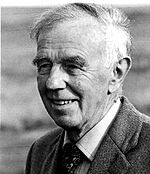Robert Gwyn Macfarlane facts for kids
Quick facts for kids
Robert Gwyn Macfarlane
|
|
|---|---|
 |
|
| Born | 26 June 1907 |
| Died | 26 March 1987 (aged 79) |
| Nationality | British |
| Alma mater | University of London |
| Known for | Haematology, science, biography |
| Awards | Cameron Prize for Therapeutics of the University of Edinburgh (1968) |
Robert Gwyn Macfarlane (26 June 1907 – 26 March 1987) was an English doctor who studied blood. He was known for his important work on how blood clots. He also helped people with haemophilia, a condition where blood does not clot properly. His discoveries changed how we understand and treat bleeding problems.
Contents
Life and Discoveries
Early Life and Interest in Blood
Gwyn Macfarlane was born in Worthing, England, in 1907. He went to medical school in London. During his studies, he saw how much people with haemophilia suffered. This made him want to learn more about how blood clots. This topic became his main focus for his whole life.
Snake Venom and Blood Clotting
Macfarlane studied the venom from many different snakes. He found that the poison from the Russell's viper was very good at making blood clot. He discovered that even a tiny amount of this venom could help stop bleeding. This medicine was later sold as Stypven. Today, Stypven Time is a common way to measure how well blood clots. This research earned him a special award in 1938.
Work in Oxford and Haemophilia
In 1940, Macfarlane started working at the Radcliffe Infirmary in Oxford. He stayed there for the rest of his career. He led a team that included Rosemary Biggs and Ethel Bidwell. They worked on understanding problems with blood clotting that people are born with. They also found ways to treat bleeding disorders. Their work helped people with haemophilia live much more normal lives.
Understanding Blood Clotting
One of Macfarlane's biggest contributions was figuring out how blood clots. He described it as an "Enzyme cascade". This means it's like a chain reaction where one step leads to the next. In 1951, he worked with Professor Alexander Stuart Douglas. Together, they found a second type of haemophilia. It is now called Haemophilia B. At first, it was known as Christmas disease, named after the first patient they studied, Stephen Christmas.
Awards and Recognition
Macfarlane was recognized for his important work. In 1956, he became a member of The Royal Society. This is a group of top scientists. In 1965, he became a professor at Oxford University. He also received the Cameron Prize for Therapeutics of the University of Edinburgh in 1966.
Writing About Science Heroes
Gwyn Macfarlane worked closely with Howard Florey. Florey was important in developing penicillin, a life-saving medicine. Macfarlane greatly admired Florey. After he retired, Macfarlane wrote a book about Florey called Howard Florey, The Making of a Great Scientist. He also wrote another book, Alexander Fleming, The Man and the Myth. This book looked at the life of Alexander Fleming, who discovered penicillin. Macfarlane felt it was important to share these stories. He also helped teach people about modern science through TV shows and other writings.
The Macfarlane Trust
After Macfarlane passed away in 1987, a group called The Macfarlane Trust was created in his honor. This trust helps people with haemophilia in the UK.
Interest factor
Video, Russell's Viper Venom, Blood clotting

